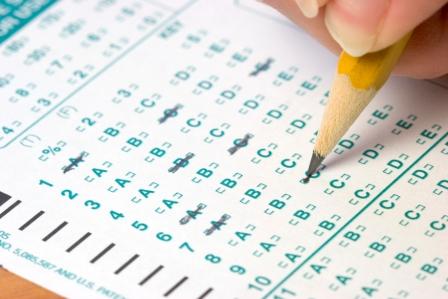Death by Scantron: A look at Standardized Testing
Every year, thousands of students take standardized tests and wait to receive their scores.
October 3, 2013
“I had to take my first standardized test when I was in 3rd grade. It was 4 hours long and I fell asleep in the middle of it,” said Sami Ahmad (10). From the MEAP to the omniscient SAT, students take dozens of standardized tests throughout their educational career, starting in elementary school and continuing through high school and into college with tests such as the MCAT, which prospective medical students take, and the GRE, which students take entering graduate school. Every year across the country, students sit down, take out their number two pencils, and wait as the testing packets are disseminated about the room. Some of these tests have even earned a special name: testing batteries, which may allude to the way in which they wear down and punish the students that take them through hours of mind-numbing bubble sheets. Overall, the excessive number of standardized tests that US students take every year is harming the learning environments of our nation’s school systems.
One important flaw of modern standardized tests is that they evaluate the performance of a student on a particular day and then extrapolate the results to assess one’s overall abilities and knowledge. One can see this particularly clearly in the two tests that weigh heavily on college admissions: the SAT and ACT. These tests factor so heavily into admissions that students will often take them multiple times to ensure a high score. “Why should one day’s performance affect your college chances as much as four years of high school work?” said Ahmad. A poor score on one of these exams decimates a student’s admissions chances, as these scores are one of three major factors in the admissions process. The extreme weight of these tests also helps to further the divide between various income brackets: “It’s highly biased, more affluent people can take classes to prepare for the tests,” Ahmad said, “[and] to weigh college admission on two tests that can be skewed like that is just ridiculous.”
Another key flaw in today’s standardized testing system is that it provides a source of extreme stress for both students and educators. On the side of the educators, poor scores on a major standardized test can lead to a loss of funding and poor rankings, which in turn draws unwanted attention from the government to remedy the problem. Students, however, face a different threat: if a student scores poorly on a particular day, and that of future effects, such as college rejections. This in effect creates an infinite loop of stress and testing, as teachers try to prepare students for the tests and students worry about their scores and the impact they will have on their future. “You can’t just give a person a test and have it determine his or her future,” said Lydia Huitt (10).
Standardized testing does provide some positive services: it helps educators understand where a school stands in comparison with others and can be an effective measuring tool. This format of testing is also objective and provides some information that educators could not glean from the usual testing procedures. The main issue, however, is that these benefits diminish when students have to take scores of tests many times over the years. While these tests individually are minimally invasive, over the course of a student’s educational career, the time adds up to whole months of class time spent in the testing room, when students could take far fewer tests and gain similar information about how a student or school stands in comparison to others. “The number of tests [students] take is really excessive,” said Huitt.
While standardized testing in and of itself is not the horror that some make it out to be, the amount of tests that students take is absurd. These tests are a metric of student achievement, but they are not an effective metric when officials use them to make policies that involve school funding, nor should they play such a large role in college admissions such as. Other factors should weigh more, such as extracurricular activities and grades. “Student acceptance and rejection based upon test scores is unreasonable,” said Ahmad. In the case of standardized testing, one item is key above all others: moderation. In order to promote a more effective learning environment, policymakers must cut standardized testing back and refocus education on the individual learner. Our educational system is not a factory system, outputting learners that have been manufactured to each meet certain standards, instead it is a cohesive unit, which policymakers must direct toward meeting the needs of each individual—it is only in this way that we can achieve our greatest success.









